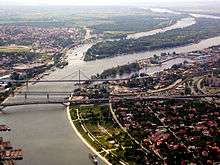Gazela Bridge
| Gazela Bridge Mост Газела Most Gazela | |
|---|---|
|
| |
| Carries | 6 lanes of the E70 and E75 |
| Crosses | Sava river |
| Characteristics | |
| Design | Beam and arch, shallow-frame beam, diagonal steel-concrete abutments |
| Total length | 332 m |
| Width | 27.5 m |
| Height | 22.8 m |
| Longest span | ~260 m |
| History | |
| Designer | Milan Đurić |
| Construction begin | 1966 |
| Construction end | 1970 |
| Statistics | |
| Daily traffic | 160,000 |
The Gazela Bridge (Serbian: Mост Газела / Most Gazela) is the most important bridge in Belgrade, Serbia, across the Sava river. It is a part of the city highway and it lies on European route E75, on the highway passing through the wider city center, connecting Belgrade with Niš to the south, and Novi Sad to the north. The bridge was designed by a group of engineers led by Milan Đurić, and built by the Mostogradnja company.
The bridge is 332 m long and 27.5 m wide, with three lanes in each direction, and total road width of 21.8 m. It is constructed as a combination of beam and arch, with shallow-frame beam and diagonal steel-concrete abutments. The maximum height of the span centre is 22.8 m at median water level.
The bridge is the main connection between downtown Belgrade and New Belgrade, and also carries the transit traffic on E70 and E75 highways through Serbia. As such, it is extremely overloaded and a cause of frequent congestion, as it leans on the main Belgrade's Mostar interchange. On average over 160,000 vehicles cross it every day (notwithstanding the impeded flow), even though it was designed to be used by 40,000. However, the bridge was almost completely redone in 2011 and it now supports up to 200,000 vehicles per day. Additional relief is expected when the Belgrade bypass is completed, which is currently under construction and is scheduled to be opened in 2013. There was also a significant relief when the new Ada Bridge was opened for traffic, on January 1, 2012.

The bridge's overhaul started in the first half of 2010 and was finished in the second half of 2011. This is the first major reconstruction of the bridge since its completion in 1970. As the bridge is part of the E75 International Road (motorway), there were traffic rushes throughout the day. It would sometimes an hour just to cross the bridge. Vehicles over 3.5 tons were prohibited from entering the city if in transit, and were instead diverted to the Belgrade bypass. However, as the Belgrade Bypass is only half completed, this posed a challenge for some truck drivers. To make matters worse, the bridge has been closed in its entirety for 7 days, causing unprecedented traffic chaos in Belgrade. To speed up the reconstruction, hundreds of workers were on the bridge 24 hours a day, 7 days a week. As a result, the bridge's overhaul was completed in record time.
Since its reconstruction, city officials stated the bridge would be able to handle 200,000 vehicles daily for the next 40 years.[1]
References
- ↑ "Gazela spremna i za 200,000 vozila". Večernje novosti. 12 August 2012. Retrieved 16 August 2012.
- "The Gazela bridge - Belgrade". YU Build. Retrieved 2007-05-19.
- "Belgrade Bypass, Serbia". CEE Bankwatch network. Retrieved 2007-05-19.
- Dr. Mihajlo Maletin (2005-09-15). "Projekat bezimenih komisija" (in Serbian).
- "Beogradu preti saobraćajni kolaps". B92. 2007-10-20.
- "U iščekivanju saobraćjnog kolapsa". Vreme. 2007-07-26.
See also
Coordinates: 44°48′11″N 20°26′28″E / 44.803°N 20.441°E